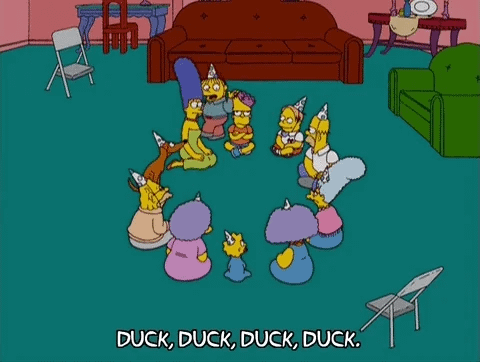Safety First
No matter duck, goose, or plastic feather shuttles, having the cork driven into the back of your head is... unpleasant... 💀 Driving it into your partner's head is equally bad, if not worse (unless you're a sociopath 😈). That's a good reason why you probably shouldn't play with your significant other.
I mean, just trying to give a heads up.
Speaking of "heads up", there is a unique situation in doubles events where the back player is late to return the opponent's shot, while their partner is still in the front.
Key Point: If you're late in the back (i.e. the shuttle is well below the net), don't hit it hard AND cross-court, because your partner's head is usually in the way. You can hit hard and straight, soft and cross-court (to the net), or even soft and straight. For the love of... your partner, there really is no need to hit hard and cross-court, especially with that forehand drive.
Let’s visualize with the help of characters from Kaguya-sama: Love is War:
Additional Safety Measures
For the front court player, you can stick your racquet behind the back of your head. I don't recommend it, but it depends how well you read the game. Instead, if you sense your partner will be late, it's better to back up to the other side of where your partner is hitting from, so if they happen to try lifting (not a great choice either), you can get back and defend the other side (i.e. cross-court).
Key Point: If you can't lift all the way to the back from the front, then why try lifting from the back? Flat shots to the net (to your opponent's service line) or flat drives (straight!) will minimize the opportunity for your opponent to get angle on their next shot, including net shots.
Also, don't look back.
Looking back is dangerous because getting a shot to the side of the face is often worse than getting one in the back of the head. This happened to my partner once at a major tournament (NO, it wasn’t from mixed doubles 😅).
My partner was playing women’s doubles and was in the front court position on offense. Her partner in the back smashed it from the backhand corner, and their opponents drove the smash deep into the other corner. Due to a slight delay in her partner retrieving the shuttle, she turned to look at the wrong moment and the shuttle hit her in the side of the eye. It was an unfortunate accident, but they eventually had to retire from the match. On the bright side, it wasn’t too serious as she recovered in time to compete the week after.
Even though the shot might not hit you, by the time you look back to the front, you may not be able to react to the next shot (imagine avoiding a shot from your partner only to turn and get hit in the face by your opponent💀). There really isn't any point in looking back.
Looking forward can help you see if your opponents are rushing to the front. At least you can take cover using the net, worst case. The secret to not getting hit is to move FORWARD. If you duck in front of the service line, it's pretty hard to get hit unless it’s floating very high at the net as if your partner is purposely trying to set you up, or if your opponent is purposely trying to hit you.
If that’s the case, you don’t have a badminton problem. You have a people problem. 😐
3 Ways to Protect Yourself at the Front
Eye injuries are quite serious, but they are more common in recreational badminton settings because beginners don't realize the danger that they're in at the front court. Sometimes I see beginners play and they fearlessly try to defend smashes in the front court. I'm not so brave.

The first way is to duck, which was covered previously.
The second way is to stick your racquet out and cover your most valued body part. I recommend the face.
The third way is to simply turn away. If you can move to the outside of your opponent's swing (i.e. outside the range of their swing follow-through), that can help too.
Final Thoughts
Try not to hit other people, especially your own partner. Try not to get hit either and make use of the tips from earlier if you’re at the front. You don't need all three, you just need to pick one.
I recommend ducking at the net, in front of the service line. Use the racquet to protect yourself if needed, but try not to interfere with shots because your partner may be able to save rally. You can watch your opponents through the net.
GOOSE! (The End)




Wise words! And great writing